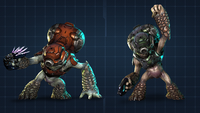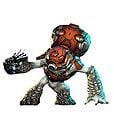Unggoy Imperial: Difference between revisions
From Halopedia, the Halo wiki
Sith Venator (talk | contribs) (I'm pretty confident that these guys can also have fuel rod guns.) |
mNo edit summary |
||
| Line 1: | Line 1: | ||
{{era|Post}} | {{era|Post}} | ||
{{Covenant Rank Infobox | {{Covenant Rank Infobox | ||
|name=Imperial | |name=Imperial | ||
Revision as of 05:22, March 8, 2014
Template:Covenant Rank Infobox Imperial[1] is a rank of Unggoy serving under the reformed Covenant.
Overview
Imperials are veterans of the Human-Covenant War, having served under the Covenant military in the hegemony's prime. As befits of their history of service, they are given slightly higher rank privileges and more durable armor from their Sangheili superiors. This includes being equipped with protective face shielding.
The Imperials seem to have a similar role to the Unggoy Ultra that served in the original Covenant, also wearing a similar helmet. They have been seen in orange, red, green, silver, and blue combat harnesses.
Gameplay
Imperial Unggoy have slightly more health than lower ranking Grunts. They also panic less and make fewer mistakes in combat. However, they are still easy to defeat individually. A single shot to the head or melee attack is usually enough to kill one.
Gallery
An Unggoy Imperial and Sangheili Storm killed in an explosion aboard the UNSC Forward Unto Dawn.
An Unggoy Imperial and Sangheili Storm confront the Master Chief in a corridor on the Dawn.
A pair of Unggoy Imperials and a Kig-Yar Storm in Spartan Ops.
List of appearances
- Halo 4 (First appearance)
- Halo: Initiation (Armor) [note 1]
- Halo: Escalation
Notes
- ^ Halo: Initiation features several Covenant soldiers depicted in the likeness of infantry classes that only exist in the new, post-war Covenant order, in a scene set during the Human-Covenant War. While this appears to be a discrepancy, said Covenant can be assumed to belong in rank categories that existed during the Covenant War, with their armor designs retroactively inserted to the earlier time period as armor variants that would later see use by the revised ranks of the post-war Covenant.
Sources
| ||||||||||||||







